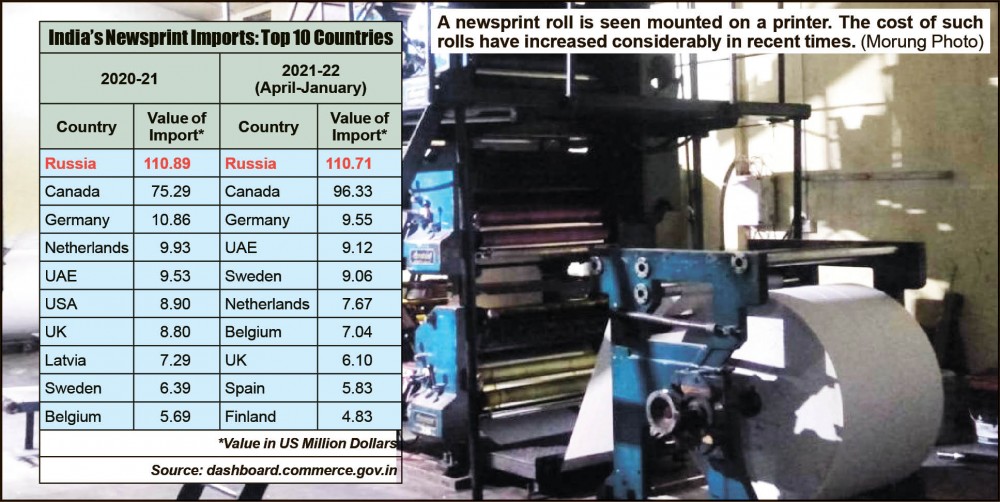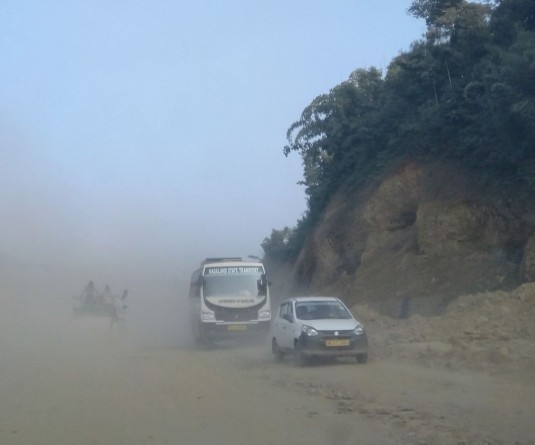
Moa Jamir
Dimapur | March 30
Newspapers in India, particularly in Nagaland, reeling under devastating negative impact of the COVID-19 for last two years, are confronting another crisis – the escalating of costs due to the ongoing Russian–Ukraine war.
The situation is particularly dire for the print media in Nagaland, the only homegrown industry in State generating substantial direct employment to working journalists as well as other ancillary employment.
Unlike the national scenario where the newspapers are mostly owned by corporate and big businesses, newspapers in Nagaland run on proprietorship, making access to capital more difficult.
Escalating costs
“The sudden increase in the prices of raw materials such as newsprint, ink and chemicals has impacted the newspaper industry throughout the world and Nagaland is no exception, where the newspapers have been struggling post COVID-19 pandemic and lockdowns,” stated Dilip Sharma, the Executive Editor of Dimapur-based Nagaland Page.
“One can see the impact in Sri Lanka, where its popular newspaper ‘The Island’ and ‘Divayina’ have already suspended their print edition due to non-availability of newsprint pointing toward the economic crisis the industry is facing,” he said, noting that the ongoing war is responsible for the economic crisis in different parts of the world.
The daily increase in fuel prices in India will naturally impact the transportation sector, thereby increasing the cost of essential commodities. And of course, the newspaper industry too will suffer, he added.
Here at The Morung Express, the manager informed that the newsprint roll, which was previously procured at Rs 66+GST per kg at the start of the year, has been increased to Rs 77+GST per kg this month, indicating a surge of over 16%.
Additionally, a newspaper plate which was earlier costing around Rs 160 per plate has been increased to Rs 200, he said.
The Indian newspaper industry in particular, is facing tougher times than ever before as an unintended consequence of the Russia invasion on Ukraine which has been continuing for over a month now. This is because India imports 45% of its news print requirements from Russia, stated K Temjen, Editor-Publisher of Tir Yimyim, an Ao language daily.
Not only in newsprint but prices have shot up for all the printing related materials, he said.
An executive of another Dimapur-based English daily also informed that their procurement of newsprint have increased from Rs 64+GST to Rs 77 +GST.
‘I have enquired with several dealers in Guwahati and the rates are more or less same everywhere,’ he added.
As a way out, he informed that talks are currently on to pay for the newsprint in installments.
A journalist associated with an Imphal-based paper also informed that they are facing the same situation. “I was informed by the management that queries have been received from three others to buy our newsprint stock due to unavailability of product in the market,” he said.
Why prices of newsprint are rising?
The price of newsprint which was on an upward trend due to COVID-19 has been doubly hit by the ongoing crisis.
According to PTI news agency, the Indian Newspaper Society (INS) in January, made a representation to the Union Finance Minister stating that the cost of paper has jumped 20% in the past three months due to demand-supply imbalance following the pandemic.
The cost was attributed to a drastic fall in supplies after 3 million tonnes of manufacturing capacities were either closed or converted to brown paper grades worldwide.
The INS then sought a waiver of 5% import duty to help cut costs, arguing that the industry that was facing headwinds from a slowing economy even before the pandemic, was ‘hit hard when most readers stopped buying newspapers and magazines on fears of them being carriers of viruses,’ the report stated.
It further sought a fiscal stimulus package for the industry or raising tariffs of government advertisements by 50% while further calling for extension of the validity of RNI (Registrar of Newspapers for India) Circulation Certificates up to March 31, 2022.
However, the Russian invasion of Ukraine has put more pressure on the supply of newsprint directly, as well as collateral effects such as rise in oil prices, volatility in foreign exchange markets, and other issues related with economic sanctions on Russia.
India’s newsprint import
Russia’s invasion of Ukraine has had many unintended consequences. One of the lesser known ones is that imported newsprint, the Times of India (ToI) reported on March 18.
Newsprint has ‘almost vanished from the market, leaving struggling to find supplies’ because Russia accounts for almost 45% of Indian newsprint imports.
Another fallout is the runaway inflation of (natural gas, coal) which constitute almost 30% of the cost of newsprint production at paper mills, it added.
A look at the monitoring Dashboard of merchandise trade maintained by the Union Ministry of Commerce and India affirmed the enormity of dependence on Russia.
According to the Dashboard, during 2021-22 financial year (April to January), India imported $290 million worth of newsprint; out of which $ 110.71 million or 38.17% of the total import were from Russia.
Canada was at second at $ 96.33 million or 33.21%. Collectively, the two countries accounted for over 71% of the total imports.
Again in 2021-22, India imported $294 million worth of newsprint, out of which $110.89 million was from Russia or 37.71% of the total import. (See table)
As per the ToI, Canadian truckers strike against the country's vaccine mandate in February also wreaked havoc on crucial supply chains.
Newsprint typically amounts to about 40–50% of the cost of producing a newspaper. Other elements like inks, aluminium plates for printing, and transportation costs are also becoming more expensive due to the global surge in commodity prices, exerting further pressure on newspaper costs, it stated.
For newspapers in Nagaland, with limited commercial activities, the impact would be more severe.
“Unlike other newspapers in other states, as Nagaland has no commercial activities, newspapers cannot rely on commercial advertisements from both the public and private sectors,” Tir Yimyim’s Temjen stated.
“Worst is newspaper publishers cannot simply enhance the cost of newspaper owing to poor economic situation in the state as many families hardly subscribe to one daily newspaper because of economic constraints,” it added.
However, given the dire situation, most newspapers in Nagaland might be forced to raise their cover prices, which would only have marginal impact. If the Russia-Ukraine crisis continues and the government remains indifferent to the crisis faced by local newspapers, it may compel them to shut down or undertake retrenchment.






